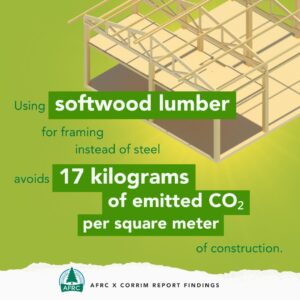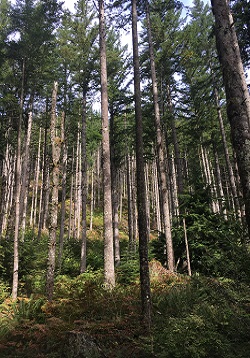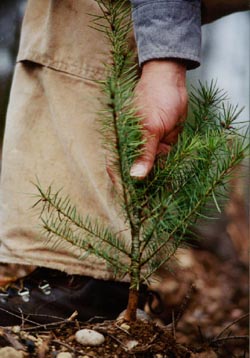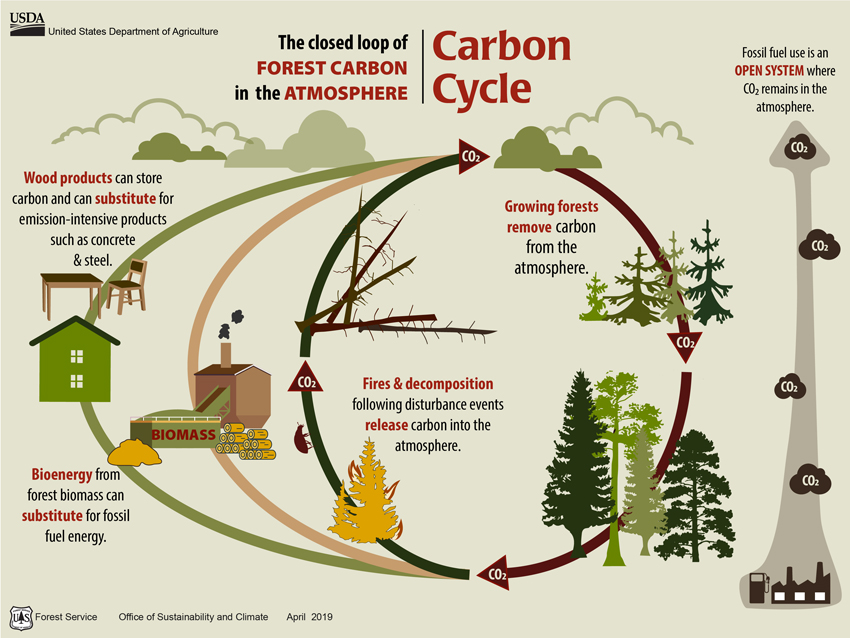DNR’s state trust lands play an essential role in maintaining Washington state’s position as a global leader in planting, growing, managing, harvesting and manufacturing high-quality and climate-friendly wood products.
Healthy, growing trees remove carbon dioxide from the atmosphere, then store that carbon as biomass, or wood. When timber from DNR trust lands are harvested, the carbon stays in the wood products for their useful life.
DNR state trust lands are managed under the strictest environmental laws in the world, while guided by modern, science-based forest practices. These practices that maintain healthy, managed forests also reduce the risks of mass carbon emission events such as catastrophic wildfires.
Washington state’s working forests and wood products sequester 12 percent of the state’s carbon emissions. Growing and sustainable harvesting wood is a natural solution to reducing carbon emissions. For this reason, the carbon footprint of our state’s forest sector is “Below Net Zero.”
Why Using Timber from DNR State Trust Lands is a Net Positive for Our Climate
Actively managing Washington’s state trust lands and using locally-sourced wood is a far better climate solution than leaving forests unmanaged.
On the half of state trust lands in western Washington that are available for timber harvest, we can make Washington-made wood products that lock in carbon for generations, while supporting thousands of family-wage jobs across the state. When we’re managing forests, we’re reducing wildfire risks while ensuring clean air, water and recreational opportunities.
The Consortium for Research on Renewable Industrial Materials (CORRIM) and the University of Washington’s Center for International Trade in Forest Products (CINTRAFOR) conducted a full carbon accounting of a DNR timber sale using established life cycle assessment data on forestry, forest operations, and manufacturing of products that were produced from that sale. The timber sale used for the analysis is the Penny Alderwood Timber Sale in Jefferson County, Washington, which included forest stands over 80 years old. That data was then compared to a similar forest that is left unmanaged. Key findings of the analysis included:
- For every acre harvested of the 80-year-old DNR stand, 11.71 metric tons more of carbon is stored or offset over the non-harvest alternative.
- Because Washington state law requires reforestation after harvest, this climate benefit grows to as much as 72 metric tons per acre over the non-harvest alternative as new trees are planted and reach the age of 40 years.
- The full carbon calculation indicates there is no carbon “debt” after harvest when accounting for substitution and leakage.
- The harvest of a mature DNR stand yields a high percentage of long-lived wood products, which results in a high and efficient transfer of carbon stored safely in the built environment.

Washington DNR Trust lands are sustainably managed with protections for water, wildlife and fish.
DNR Trust Lands are managed on a sustained yield basis, meaning timber is harvested at a rate that is in balance with, and does not exceed, the growth rate of the forest. On average three trees are planted for every tree harvested. That means during planting season, there are roughly 400 trees per acre planted to replace those harvested. DNR lands are managed under landmark conservation plans that provide cool, clean water to sustain salmon populations and wildlife habitat for species that live in forested habitats.
Using modern forestry science and the latest technology, harvests generate revenue for schools and community services, while also achieving complex forest conditions, protecting riparian habitats, providing quality recreational experiences and meeting the needs of diverse wildlife species. In Western Washington, over 45 percent of trust lands are already set aside for old-growth, riparian protections, and wildlife species.
Building with DNR-managed, Washington-grown wood removes carbon from the atmosphere.
Building with natural, sustainable and renewable resources is the best way to move toward a lower carbon economy. Building with Washington-grown wood is a key solution to climate change because it requires less energy to manufacture compared to other materials. Every ton of wood holds 1,000 pounds of carbon. That is equal to 3,667 pounds of carbon dioxide removed from the atmosphere.
The benefit to our climate is magnified by the carbon absorbed by the forest growing to replace any trees harvested. When wood products replace more energy intensive building materials, the carbon benefits of Washington-grown wood increases.
DNR trust lands help reduce our dependency on imported wood products.
Sustainably harvesting timber from DNR trust lands reduces our dependency on importing wood products from other countries, many with weak environmental and forest practice regulations. Plus, it decreases our carbon footprint. Meeting our own demand for wood products minimizes fossil fuel consumption by eliminating the need to transport more raw materials and wood products from hundreds or thousands of miles away.
 What about “Old Growth” on DNR Trust Lands?
What about “Old Growth” on DNR Trust Lands?
While young and fast-growing trees can sequester carbon at faster rates, large and older trees can also store large amounts of carbon. Yet researchers have learned that old, unmanaged forests reach a saturation point after a number of years. At that point, carbon uptake ceases. After longer periods of high carbon sequestration, carbon storage decreases and eventually comes to a stop. This happens when a forest reaches an equilibrium, where, through the respiration of trees and degradation of organic matter in the soil, it emits as much CO2 into the atmosphere as it absorbs through photosynthesis. That’s why, over the long-term, cumulative carbon storage is greater in managed forests with timber harvests, compared to unmanaged forests where there is no timber harvest.
Nonetheless, DNR has several policies in place to conserve older forests. Nearly half of DNR trust lands in western Washington are no longer available for sustainable timber management under its Habitat Conservation Plan (HCP) and other policies set by the Board of Natural Resources. Nearly 90 percent of the stands over 120 years old are already set aside under the HCP and board policy. And every year, the DNR is growing additional acres of older forests as lands set aside mature under the HCP.
To maximize the ability of DNR Trust Lands to sequester and store carbon, it is important for land managers to maintain the continuous cycle of forestry- the planting, growing and harvesting of trees, and the manufacture of wood products that are made here in Washington and store carbon for life. By keeping forests as forests, and by keeping forests healthy and productive, DNR trust lands can not only support education, community services and jobs, it can continue to be a part of Washington’s climate solution for current and future generations.





